3D Imaging Sonar
-
- Lockheed Martin’s Revolutionary AUV Marine Technology, Jan 2014 #30
During the OTC Brasil 2013, one of the standout presentations was on the Lockheed Martin Marlin AUV. At first glance it resembles what you’d expect from any top of the line AUV. Yet on closer examination it offers capabilities that may be real game-changers for the industry. After the presentation MTR’s Correspondent in Brazil, Claudio Paschoa spoke to Dan McLeod, Senior Program Manager at Lockheed Martin.
Although the Marlin AUV is presented as targeted for customers who conduct subsea infrastructure surveys and inspections, it is capable of much more, as it can be configured to operate subsea Xmas tree valves and other such equipment, which until now have been a territory solely for ROVs.
The Marlin AUV can also be useful for simpler tasks such as surveying a large area of uncharted seabed, where an operator plans to place subsea systems, such as Xmas trees, manifolds, subsea pumps and subsea pipelines, during the early phases of field development or to examine an area of subsea structures prior to decommissioning and provide operators with significant improvements over general visual inspection (GVI) by the addition of sensors that produce 3D models of the structure being inspected. “Additional benefits include rapid response when a loss of well containment requires large standoff distances between the host vessel and the sensing platform. 3D geo-registered models of the entire scene can be collected within hours of the incident providing responders with a clear vision of the underwater scene along with in-situ status of critical components,” said McLeod.
Lockheed Martin developed and tested the Marlin AUV employing a Coda Octopus Echoscope 3D imaging sonar as the primary inspection sensor. The Echoscope produces a 128 x 128 matrix of receive beams at a rate of 5/second; a high-density return imaged from multiple aspects that results in a 3D image of the desired objects. The Marlin’s software geo-registers each image pixel and constructs a 3D model using advanced image processing techniques. The result is a high-resolution 3D model of the target structure. According to McLeod, “Introduction of new sensors support even more advanced capabilities leading to autonomous metrology, hydrocarbon detection tracking and fingerprinting, non-contact corrosion potential measurement, thermal measurements and 3D underwater scanning lasers.”
The Marlin’s sensor suite can generate accurate, hi-resolution, 3D, geo-referenced models, showing a clear view of subsea structures, including the use of lasers to produce clear images in murky waters. The 10-ft. submersible is highly maneuverable and is able to operate in tight spaces. It can reportedly perform up to four times faster inspections, delivering higher fidelity information in hours versus days. Traditional means of inspecting subsea equipment employ visual sensors such as video or still cameras mounted on ROVs that are controlled through umbilicals from a dedicated vessel on the surface. This requires significant topside support equipment and skilled operators on site to control and maintain the ROV. While the quality of images has improved with the advent of HD sensors, image quality is often degraded by movement of the cameras and the turbidity of the water, potentially reducing the effectiveness of inspections. The final data provided to clients is often composed of many hours of recorded video that must be archived and revisited for detailed examination, which in turn increases the time it takes to make informed decisions.
While workclass ROVs are a standard in the performance of IRM tasks in deepwater, AUV use is starting to make some inroads as more sophisticated units such as the Marlin AUV become more reliable and efficient. While ROV use still dominates, the inherent cost structure, which includes a large DPII vessel, volumes of deck space and experienced ROV technicians and pilots, are cumulatively helping to open the door for AUV systems for opportunities.
(As published in the January/February 2014 edition of Marine Technology Reporter - www.seadiscovery.com)
-
- d’ROP Bibby’ Hydromap’s Custom-built ROV Marine Technology, May 2015 #44
equipment DVL, Sonar, MRU Survey Capability TSS350, TSS440, TSS Dual Track, Multi-beam echo sounder, side scan sonar, gradiometer, 3D imaging sonar Deployment Through moon-pool or over-side/cantilever SWL 4100 kg on bottom layer Average line speed >30m/min Lift umbilical Double
-
- Meet the Future of Visualization and Mapping Sonars Marine Technology, Jan 2018 #22
directed by our R&D department, we never stand still. All of our real-time 3D sonars use a proprietary technology and remain the only true real-time 3D imaging sonar, transmitting a large volumetric pulse of sound energy which generates typically over 16,000 beams for every acoustic transmission or ‘ping’. We
-
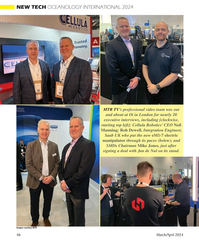 )
March 2024 - Marine Technology Reporter page: 46
)
March 2024 - Marine Technology Reporter page: 46NEW TECH OCEANOLOGY INTERNATIONAL 2024 MTR TV’s professional video team was out and about at Oi in London for nearly 20 executive interviews, including [clockwise, starting top left]: Cellula Robotics’ CEO Neil Manning; Rob Dewell, Integration Engineer, Saab UK who put the new eM1-7 electric manipulator
-
 )
March 2024 - Marine Technology Reporter page: 44
)
March 2024 - Marine Technology Reporter page: 44NEW TECH OCEANOLOGY INTERNATIONAL 2024 Image courtesy Metron/Cellula Teledyne Marine acquires Valeport: Matt Quartley, MD, Valeport and Ole Søe-Pedersen, VP & Image courtesy Teledyne Marine GM Teledyne Marine announce the deal in London. Pictured (L-R): Cellula Robotics, President, Eric Jackson, Metron
-
 )
March 2024 - Marine Technology Reporter page: 43
)
March 2024 - Marine Technology Reporter page: 43Image courtesy Kongsberg Discovery Image courtesy Teledyne Marine New Products Teledyne Marine had its traditional mega-booth at Oi, busy start to ? nish. Image courtesy Greg Trauthwein offers quality sub-bottom pro? ling capability without the need tion of offshore windfarms. GeoPulse 2 introduces new
-
 )
March 2024 - Marine Technology Reporter page: 42
)
March 2024 - Marine Technology Reporter page: 42NEW TECH OCEANOLOGY INTERNATIONAL 2024 Image courtesy Greg Trauthwein Image courtesy BIRNS MacArtney launches the new ultra-compact ø12.7 mm SubConn Nano connector. Innovative connectivity built on 45 years of ? eld-proven and market-trusted design. Image courtesy MacArtney Birns celebrated its 70th
-
 )
March 2024 - Marine Technology Reporter page: 41
)
March 2024 - Marine Technology Reporter page: 41Image courtesy Outland Technology Image courtesy Exail Image courtesy Submaris and EvoLogics Vehicles The ROV-1500 from Outland Technology represents a leap forward in underwater robotics, a compact remotely operated vehicle (ROV) weighing in at less than 40 lbs (19kg) the ROV- 1500 is easy to transport
-
 )
March 2024 - Marine Technology Reporter page: 33
)
March 2024 - Marine Technology Reporter page: 33regulated industry in the world.” How- ever, commercial success depends on many factors, not least a predictable OPEX. Over the past four years, SMD has worked with Oil States Industries to calculate cost per tonne ? gures for prospective customers. Patania II uses jet water pumps to Oil States’
-
 )
March 2024 - Marine Technology Reporter page: 32
)
March 2024 - Marine Technology Reporter page: 32FEATURE SEABED MINING by a sea? oor plume from its pilot collection system test. pact, nodule collection system that utilizes mechanical and The Metals Company recently signed a binding MoU with hydraulic technology. Paci? c Metals Corporation of Japan for a feasibility study on The company’s SMD
-
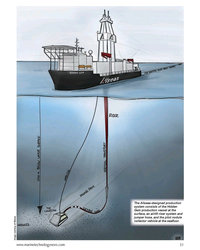 )
March 2024 - Marine Technology Reporter page: 31
)
March 2024 - Marine Technology Reporter page: 31The Allseas-designed production system consists of the Hidden Gem production vessel at the surface, an airlift riser system and jumper hose, and the pilot nodule collector vehicle at the sea? oor. Image courtesy of Allseas www.marinetechnologynews.com 31 MTR #3 (18-33).indd 31 4/4/2024 2:12:41
-
 )
March 2024 - Marine Technology Reporter page: 30
)
March 2024 - Marine Technology Reporter page: 30the Digital twin technology analyzes data gathered from mul- umbilical in a single plane during collector operations. tiple sensors and assets to enable 3D visualization of op- The collector’s front-mounted Coandã-effect nozzles guide erations in real time. AI modelling can then determine the water over
-
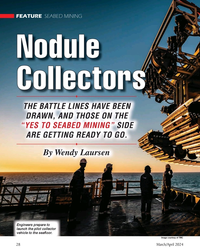 )
March 2024 - Marine Technology Reporter page: 28
)
March 2024 - Marine Technology Reporter page: 28FEATURE SEABED MINING Nodule Collectors THE BATTLE LINES HAVE BEEN DRAWN, AND THOSE ON THE “YES TO SEABED MINING” SIDE ARE GETTING READY TO GO. By Wendy Laursen Engineers prepare to launch the pilot collector vehicle to the sea? oor. Image courtesy of TMC 28 March/April 2024 MTR #3 (18-33).
-
 )
March 2024 - Marine Technology Reporter page: 26
)
March 2024 - Marine Technology Reporter page: 26of the South and West Paci? c Regional Centre of Seabed 2030. Kevin in the seismic lab at Greta Point looking at the Hunga Tonga-Hunga Ha’apai volcano 3D map completed with data from the TESMaP voyage on Tongaroa and later ? lled in by Maxlimer from SEA-KIT International. Jasmin McInerney, Ocean Instrument
-
 )
March 2024 - Marine Technology Reporter page: 25
)
March 2024 - Marine Technology Reporter page: 25remains unknown about subma- vorite was the multibeam echo sounder, an undersea landslide had occurred.” rine volcanoes, explained Mackay, as re- generating 3D images of the sea? oor us- At HT-HH, scientists mapped a total of searchers return to the eruption site more ing beams of sound waves. “This is the
-
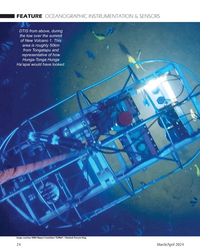 )
March 2024 - Marine Technology Reporter page: 24
)
March 2024 - Marine Technology Reporter page: 24FEATURE OCEANOGRAPHIC INSTRUMENTATION & SENSORS DTIS from above, during the tow over the summit of New Volcano 1. This area is roughly 50km from Tongatapu and representative of how Hunga-Tonga Hunga Ha’apai would have looked. Image courtesy NIWA-Nippon Foundation TESMaP / Rebekah Parsons-King 24
-
 )
March 2024 - Marine Technology Reporter page: 23
)
March 2024 - Marine Technology Reporter page: 23elatively inactive since 2014, the Hunga Tonga–Hunga Ha‘apai (HT-HH) submarine volcano began erupting on December 20, 2021, reaching peak intensity on January 15, 2022. This triggered tsunamis throughout the Pa- R ci? c, destroyed lives and infrastructure, and generated the largest explosion recorded
-
 )
March 2024 - Marine Technology Reporter page: 22
)
March 2024 - Marine Technology Reporter page: 22FEATURE OCEANOGRAPHIC INSTRUMENTATION & SENSORS Aerial view of HT-HH volcano, showing new multibeam depth data overlaid on islands satellite image. © SEA-KIT, NIWA-Nippon Foundation TESMaP 22 March/April 2024 MTR #3 (18-33).indd 22 4/4/2024 9:08:10 AM
-
 )
March 2024 - Marine Technology Reporter page: 19
)
March 2024 - Marine Technology Reporter page: 19FiGS report includes; Potential pro? le plot for cloud-based online reporting and visualization, FORCE Tech- pipelines/Potential distribution plot for 3D structures to iden- nology can provide a central portal for information on all CP tify hotspots/areas of under-protection, Anode current output at
-
 )
March 2024 - Marine Technology Reporter page: 18
)
March 2024 - Marine Technology Reporter page: 18TECH FEATURE IMR There are also weaknesses in terms of accuracy because of FiGS Operations and Bene? ts signal noise and the ability to detect small ? eld gradients. In Conventional approaches to evaluating cathodic protection this process there is a risk that possible issues like coating (CP)
-
 )
March 2024 - Marine Technology Reporter page: 16
)
March 2024 - Marine Technology Reporter page: 16TECH FEATURE IMR Image courtesy FORCE Technology OPTIMIZING CATHODIC PROTECTION SURVEY USING NON-CONTACT SENSORS By Svenn Magen Wigen, FORCE Technology he principle behind sacri? cial anodes, which are water structures, reducing the need for frequent repairs and used to safeguard underwater pipelines
-
 )
March 2024 - Marine Technology Reporter page: 15
)
March 2024 - Marine Technology Reporter page: 15sensor options for longer mission periods. About the Author For glider users working in ? sheries and conservation, Shea Quinn is the Product Line Manager the Sentinel can run several high-energy passive and active of the Slocum Glider at Teledyne Webb acoustic sensors, on-board processing, and imaging
-
 )
March 2024 - Marine Technology Reporter page: 14
)
March 2024 - Marine Technology Reporter page: 14TECH FEATURE TELEDYNE SLOCUM GLIDERS to hold over 3.5 times as many lithium primary batteries as the the water column and its thrusters give it the ability to stay standard Slocum Glider, and to physically accommodate up to on track in strong currents or other dif? cult ocean condi- 8 different sensor
-
 )
March 2024 - Marine Technology Reporter page: 11
)
March 2024 - Marine Technology Reporter page: 11assist in identifying mines and act as a neutralization device. About the Author Bottom mines pose even greater chal- David R. Strachan is a defense analyst and founder of lenges. Unlike contact mines, bottom Strikepod Systems, a research and strategic advisory mines utilize a range of sensors to
-
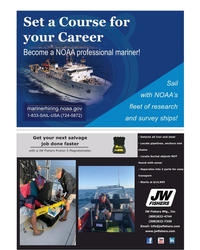 )
March 2024 - Marine Technology Reporter page: 7
)
March 2024 - Marine Technology Reporter page: 7Set a Course for your Career Become a NOAA professional mariner! Sail with NOAA’s fleet of research marinerhiring.noaa.gov 1-833-SAIL-USA (724-5872) and survey ships! - Detects all iron and steel Get your next salvage - Locate pipelines, anchors and job done faster chains with a JW Fishers
-
 )
March 2024 - Marine Technology Reporter page: 2
)
March 2024 - Marine Technology Reporter page: 2March/April 2024 On the Cover Volume 67 • Number 3 Image courtesy NIWA-Nippon Foundation TESMaP / Rebekah Parsons-King 8 Subsea Defense Black Sea Mines When the shooting stops in the Ukraine, the tough work of clearing mines will commence. By David Strachan 12 Gliders Slocum Sentinel 22 Teledyne
-
 )
April 2024 - Maritime Reporter and Engineering News page: 48
)
April 2024 - Maritime Reporter and Engineering News page: 48Index page MR Apr2024:MN INDEX PAGE 4/5/2024 1:33 PM Page 1 ANCHORS & CHAINS MILITARY SONAR SYSTEMS tel:+44 (0) 1752 723330, [email protected] , www.siliconsensing.com Anchor Marine & Supply, INC., 6545 Lindbergh Houston, Massa Products Corporation, 280 Lincoln Street, SONAR TRANSDUCERS
